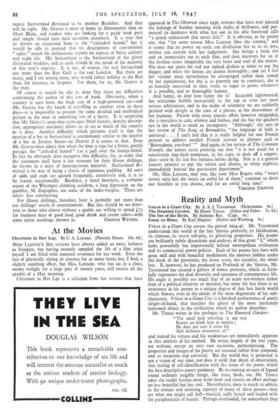Reality and Myth
Voices in a Giant City. By A. S. J. Tessimond. (Heinemann. 6s.) The Haunted Garden. By Henry Treece. (Faber and Faber. 7s. 6d.) The Inn of the Birds. By Anthony Rye. (Cape. 6s.) Essay on Rime. By Karl Shapiro. (Seeker and Warburg. 6s.)
Voices in a Giant City covers the period 1934-47- Mr. Tessimond understands this world of the late 'thirties perfectly, its falsification, its clamour, its secret self-pity, its glittering properties. His poems are brilliantly subtle dissections and analyses of that great " I," which lurks powerfully but impersonally behind metropolitan civilisation and its commercial power politics. Each of his poems lays bare with great skill and with beautiful modulation the motives hidden under the mask of the prostitute, the lesser mist, the occultist, the smart boy. If, however, he has produced no Prufrock of the 'thirties, Mr. Tessimond has created a gallery of minor portraits, which as faith- fully represents the dual diversity and sameness of contemporary life. His angle is possibly too much that of an acute eye-witness rather than of a political observer or moralist, but none the less there is an awareness in his poems to a unique degree of that less harsh world which flowers even in the minds of the most degenerate of his sub- characters. Voices in a Giant City is a finished performance of poetic sleight-of-hand, that matches the glitter of the most intricately fashioned object in the civilisation which its author describes.
Mr. Treece writes in the prologue to The Haunted Garden:
"The small bird whistling in my tree Knows no black hate or enmity ; He does not care if cities fall And darkness overcovers all."
and indeed his virtues and his weaknesses are immediately apparent in this analysis of his method. He writes largely of the war years, yet without, except on very rare occasions, particularising. The properties and images of his poetry are seasonal rather than temporal, and so recurrent and universal. But the world that is projected is not a vision of our time nor does it yield that detail of observation, that feeling of self-identification with the scene of the poem, which the best descriptive poetry produces. By re-creating an aura of legend round ordinary tangible things, like trees, birds, sea, Mr. Treece takes the reader further away from them and creates an effect perhaps no less beautiful but less real. Nevertheless, there is much to admire in the texture and arresting tapestry of many of these poems—they are what one might call full—musical, sadly lyrical and loaded with the paraphernalia of beauty. Perhaps overloaded, for somewhere they lack that core of reality, that hard curb of thought which Mr. Treece so often sacrifices for feeling. But when he is on surer ground, con- fining himself to sober and exact description, as in the poem Waterford, and when he dispenses with his role of myth-maker, Mr. Treece writes extremely well.
The Inn of the Birds, illustrated by the author, contains fifty very short descriptive poems of bird life. Mr. Rye does not write on more than one level, and many of these poems are extremely slight ; yet their cumulative effect is one of a disturbing beauty, though the echoes and overtones of symbolism which are suggested are never apparent in the actual poems. But they are all beautifully observed, coherent and unsentimental. The Partridge shows Mr. Rye's manner:
"Under the violet light that lies In February after-skies
Before the rains have washed -them silver
That trickle down to dyke and culver, The partridge on the plough-ridge creaks, And new gloss in his feather sleeks." •
Mr. Shapiro's Essay on Rime is a modern Art Poitique, remarkably sustained in the quality of its writing, which is technically almost as accomplished as Auden's, though the similarity does not end there. Perhaps the greatest compliment one can pay is to say that it could not have been better written in prose. ALAN Ross.



































 Previous page
Previous page